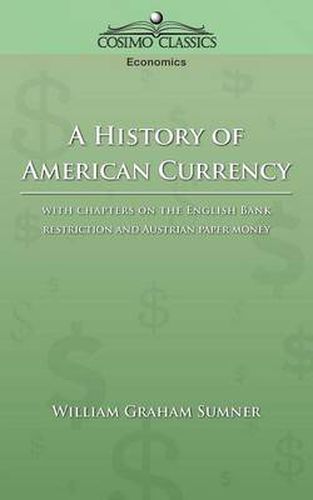Readings Newsletter
Become a Readings Member to make your shopping experience even easier.
Sign in or sign up for free!
You’re not far away from qualifying for FREE standard shipping within Australia
You’ve qualified for FREE standard shipping within Australia
The cart is loading…






This title is printed to order. This book may have been self-published. If so, we cannot guarantee the quality of the content. In the main most books will have gone through the editing process however some may not. We therefore suggest that you be aware of this before ordering this book. If in doubt check either the author or publisher’s details as we are unable to accept any returns unless they are faulty. Please contact us if you have any questions.
A fascinating but often overlooked topic is the establishment of currency in a new nation. The process involves not only a host of unknown and complicated political factors, but also economics and the culture of the new nation. In A History of American Currency, Yale Professor William G. Sumner examines the development of the monetary system in the United States, from the colonial era through the Civil War. He noted that the earliest British settlers brought with them virtually no money; the English government wouldn’t allow it, and the Puritans had little or no use for it. Gradually, the settlers traded wampumpeag with their Native American neighbors, and eventually currency was developed to pay soldiers, finance expeditions, and trade with other nations. Sumner also covers the English Bank Restriction of 1797, the Bullion Report of 1810, and the development of Austrian paper money. WILLIAM GRAHAM SUMNER was a professor of political and social science at Yale University and became known as a Social Darwinist and advocate of the laissez faire principle in economics. Besides writing a number of books on sociology, history, and economics, he was also influential in the movement to modernize the American university system.
$9.00 standard shipping within Australia
FREE standard shipping within Australia for orders over $100.00
Express & International shipping calculated at checkout
This title is printed to order. This book may have been self-published. If so, we cannot guarantee the quality of the content. In the main most books will have gone through the editing process however some may not. We therefore suggest that you be aware of this before ordering this book. If in doubt check either the author or publisher’s details as we are unable to accept any returns unless they are faulty. Please contact us if you have any questions.
A fascinating but often overlooked topic is the establishment of currency in a new nation. The process involves not only a host of unknown and complicated political factors, but also economics and the culture of the new nation. In A History of American Currency, Yale Professor William G. Sumner examines the development of the monetary system in the United States, from the colonial era through the Civil War. He noted that the earliest British settlers brought with them virtually no money; the English government wouldn’t allow it, and the Puritans had little or no use for it. Gradually, the settlers traded wampumpeag with their Native American neighbors, and eventually currency was developed to pay soldiers, finance expeditions, and trade with other nations. Sumner also covers the English Bank Restriction of 1797, the Bullion Report of 1810, and the development of Austrian paper money. WILLIAM GRAHAM SUMNER was a professor of political and social science at Yale University and became known as a Social Darwinist and advocate of the laissez faire principle in economics. Besides writing a number of books on sociology, history, and economics, he was also influential in the movement to modernize the American university system.